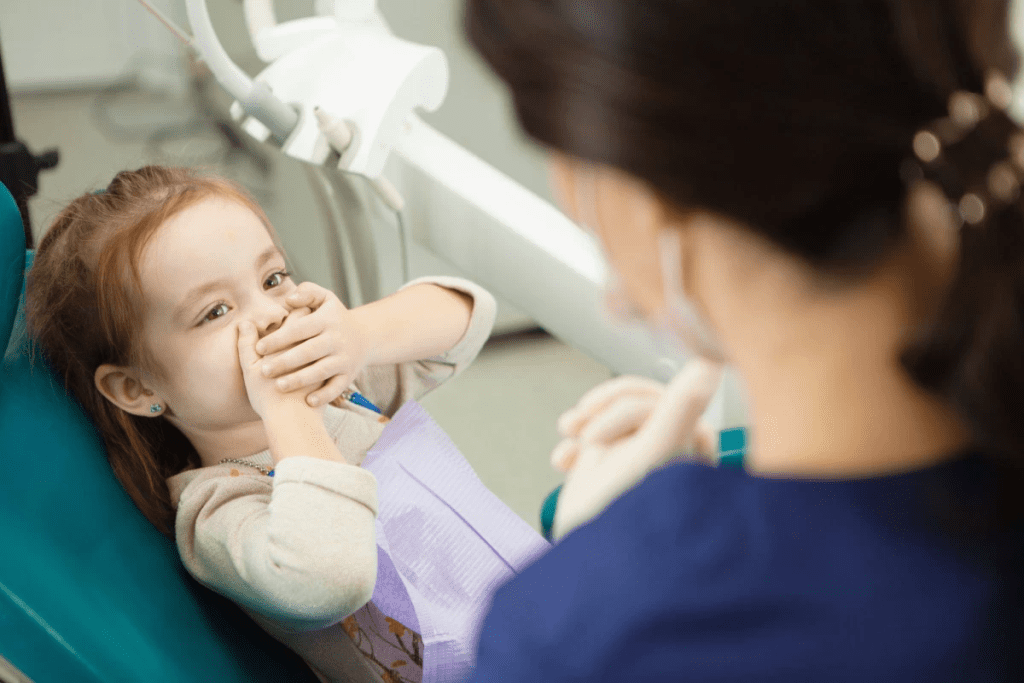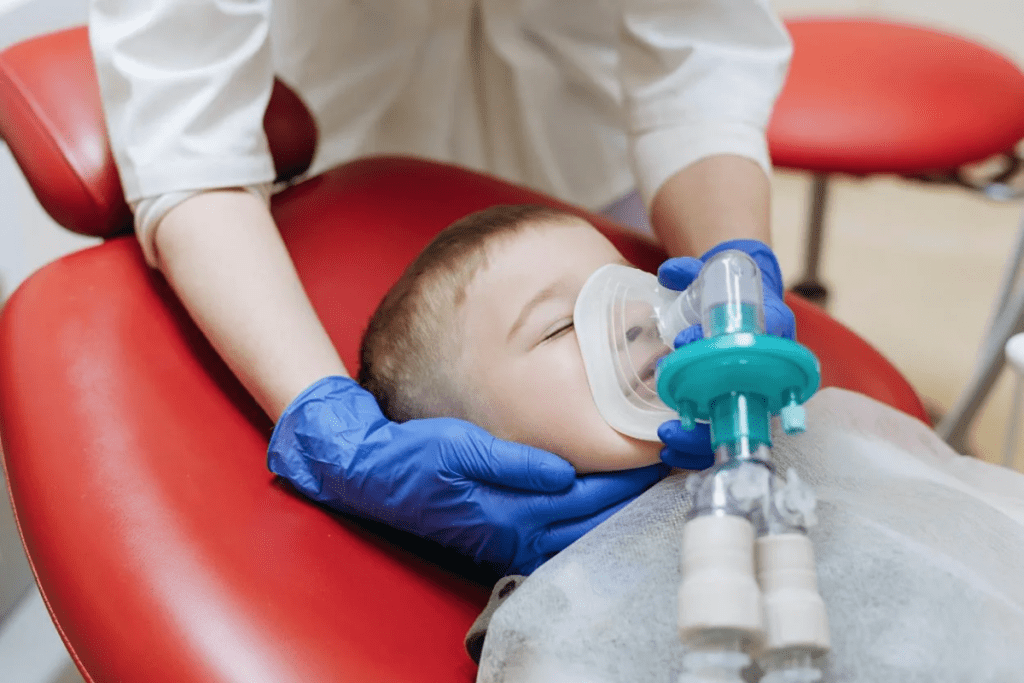Last Updated on November 14, 2025 by

Parents often worry about their child’s safety during general anesthesia. At Liv Hospital, we use proven methods and advanced monitoring to keep children safe throughout their procedures. Studies show that 94% of pediatric general anesthesia cases are completed in under 3 hours.
Thinking about your child going under general anesthesia can be stressful, but knowing that safety is our top priority can ease your mind. In most cases, a 3-year-old can safely remain under general anesthesia for less than 3 hours, which aligns with international safety guidelines.
At Liv Hospital, our pediatric anesthesia team works with care and precision to ensure every child has the safest experience possible.
Anesthesia for toddlers is all about keeping them safe. Studies show 94% of pediatric anesthesia cases last under 3 hours. The median time for all children is 57 minutes, and the 90th percentile is 145 minutes.

Research shows that anesthesia time is key for toddlers’ safety. The safe limit is under 3 hours. Many studies have looked into how long anesthesia affects young children.
Safety thresholds are based on lots of research. They consider the child’s age, the procedure, and the anesthesia. This helps doctors manage risks in toddler anesthesia.
Anesthesia time is very important for toddlers. Their brains and bodies are growing. Long anesthesia can harm their development, so it’s important to keep it short.
Longer anesthesia times can increase risks for young children. So, keeping anesthesia short is a main goal in pediatric care.
Age affects anesthesia time differently. For 3-year-olds, their growth and the procedure’s complexity matter.
3-year-olds are in a special spot because they’re young but more developed than babies. Knowing these differences helps in safe anesthesia care for all ages.
Anesthesia time is key in kids’ surgeries, affecting safety and results. Knowing how long these surgeries last can ease worries about anesthesia safety.
Studies show the median general anesthesia time for kids is 57 minutes. This info gives a basic idea of what to expect in pediatric surgeries. Remember, the time can change a lot depending on the surgery and the child’s health.
For example, surgeries like putting in tympanostomy tubes last about 18.4 minutes on average. This shows how different surgeries can have different lengths.

Each pediatric surgery has its own usual time. Here are some common ones:
These times are just estimates. The real time can change based on the surgery’s complexity and the child’s health.
While most surgeries stick to expected times, some can take longer. Complex cases, unexpected problems, or the need for extra steps can make procedures longer.
Parents should know that longer surgeries might raise anesthesia risks. But, the medical team is ready to manage these risks and keep kids safe.
It’s important to know how general anesthesia works on young kids. This type of anesthesia helps them not feel pain during surgeries or other medical procedures. We watch them closely to make sure they stay asleep.
Pediatric anesthesia uses special drugs and methods for kids. Anesthesiologists must think about the child’s age, weight, and health history when giving anesthesia. They aim to keep the child comfortable and safe.
Drugs work differently in kids than in adults. Kids’ liver and kidney functions are not fully grown. This changes how drugs are broken down in their bodies.
Toddlers are different from adults in how they react to anesthesia. Their small airways and fast metabolism need special care. Also, their brains are developing, which affects how they react to drugs.
Keeping an eye on the brain during surgery is key for young kids under anesthesia. Tools like bispectral index (BIS) monitoring help us see how deep the anesthesia is. This way, we can make sure the child is comfortable and safe.
By watching the brain and adjusting the anesthesia, we lower the risks for young children. This helps us give the best care to our youngest patients.
The FDA has warned about the risks of anesthesia in young kids. This is based on studies that show possible harm to brain development. Parents are getting concerned.
The FDA has set rules for kids under 3. They say elective procedures with anesthesia should wait until after 3 if possible. But, this rule doesn’t apply to surgeries that must happen right away.
Delaying a needed procedure can worry parents. It’s key to talk about the risks and benefits with your doctor. This helps make a good choice.
Research on anesthesia in young kids is ongoing. Studies in animals show that long or repeated anesthesia use can harm brain cells and cause lasting cognitive problems. But, the impact on human kids is not fully understood yet.
The ways anesthesia might affect brain development are complex. It depends on the type of anesthetic, how long it’s used, and the child’s age at the time.
Often, the good of anesthesia for young kids is more than the risks. For needed surgeries, anesthesia is key for the child’s comfort and the surgery’s success. Doctors carefully decide if anesthesia is needed and talk about risks with parents.
Parents should know about the FDA’s warnings and talk to their child’s doctor. By understanding the guidelines and research, parents can make smart choices for their child’s health.
It’s important for parents and doctors to know about the risks of long-term general anesthesia. Anesthesia is key for many medical procedures. But, using it for a long time can harm young children a lot.
Long-term general anesthesia can cause quick effects right after the procedure. These can be things like mild nausea and feeling groggy. These usually go away in a few hours.
But, some kids might have bigger problems. They could face breathing issues or get really upset.
There’s ongoing research on the long-term effects of long anesthesia on kids. Some studies hint at a possible link to brain development problems. But, the proof is not solid yet.
It’s key for parents to talk about these risks with their doctor.
Some things can make the risks of long anesthesia worse. These include the child’s health, any past health problems, and how complex the procedure is. Kids with breathing or heart issues need extra watch during and after anesthesia.
Knowing these risks and working with doctors helps parents make better choices for their kids. It’s also vital to follow instructions after the procedure closely to avoid more problems.
At Liv Hospital, we make your child’s safety our top priority. We have strict safety protocols in place. Our team works hard to ensure your child receives the best care, following the latest medical standards.
We use advanced monitoring techniques to keep a close eye on your child’s health. Our state-of-the-art equipment gives us real-time data. This helps our anesthesiologists make quick and accurate decisions.
Our multidisciplinary team includes experts in anesthesia, surgery, and nursing. They work together to give your child the best care. This teamwork helps us handle any issues that might come up during the procedure.
At Liv Hospital, we stick to evidence-based best practices in pediatric anesthesia. This means our methods are backed by the latest research and guidelines. We’re always learning to give your child the best care possible.
By using modern monitoring, a team approach, and evidence-based practices, we create a safe space for your child. This ensures they receive top-notch care during anesthesia.
When your toddler is under anesthesia, knowing what to expect during recovery can ease your concerns. We understand that this period can be challenging for parents, and being informed is key to navigating it successfully.
Children typically recover quickly from anesthesia. The wake-up process usually begins within 15 to 30 minutes after the procedure is completed. During this time, our medical team closely monitors your child’s vital signs to ensure a smooth recovery.
Some toddlers may wake up calmly, while others might be more disoriented or agitated. Our experienced staff is trained to comfort and care for your child during this phase, and we encourage you to be present to provide reassurance.
Anesthesia is designed to be cleared from the body relatively quickly. Most anesthetics are metabolized and eliminated within a few hours after the procedure. But some effects might linger, and it’s not uncommon for children to feel groggy or tired for the rest of the day.
After the procedure, we monitor your child closely for any immediate reactions to the anesthesia. Parents can usually be present during the recovery process and should be aware of possible side effects such as nausea, vomiting, or irritability.
It’s essential to follow our post-procedure instructions carefully to ensure your child’s safety and comfort during the recovery period. We provide detailed guidance on how to care for your child at home, including managing pain and recognizing signs that may require further medical attention.
By understanding what to expect during the recovery from anesthesia, you can better support your child through this process. If you have any concerns or questions, our team is always available to provide guidance and reassurance.
Anesthesia is key for kids’ medical care, letting them get through procedures without pain. At Liv Hospital, we aim to give top-notch healthcare. We also offer full support and guidance to international patients.
We know how to make anesthesia safe for kids by following the best practices. This balance is vital in pediatric care. Here, safety and success are both very important.
We follow strict rules and use the latest monitoring tools to keep kids safe. Every child reacts differently to anesthesia. Our team works together to give each child the care they need.
In pediatric care, we must think carefully about the benefits and risks of anesthesia. This way, we can avoid problems and make sure kids get the care they need safely.
For a 3-year-old, the safe time under anesthesia is usually less than 3 hours. Most pediatric cases stay within this time frame, at 94%.
Several things affect how long anesthesia lasts in kids. These include the type of surgery, the child’s health, and the anesthesiologist’s expertise.
General anesthesia is safe for young kids when given by skilled professionals. But, long or repeated use can have risks.
Long anesthesia can lead to breathing and heart problems. The FDA warns about these risks in kids under 3.
Modern tools like EEG and other neurophysiological monitors track brain function during anesthesia.
Anesthesia’s effects usually fade in a few hours after surgery. But, it depends on the type of anesthesia and the child’s health.
Kids often feel sleepy, nauseous, and may vomit after anesthesia. These effects are usually short-lived and go away in a few hours.
To keep your child safe, follow the advice of experienced doctors. Stick to proven protocols and watch your child’s vital signs closely.
At Liv Hospital, we use the latest monitoring tools and a team approach. We also follow the best evidence-based practices for your child’s safety.
General anesthesia is usually safe, but there might be long-term effects. Yet, the benefits often outweigh the risks when used carefully and under medical watch.
Subscribe to our e-newsletter to stay informed about the latest innovations in the world of health and exclusive offers!